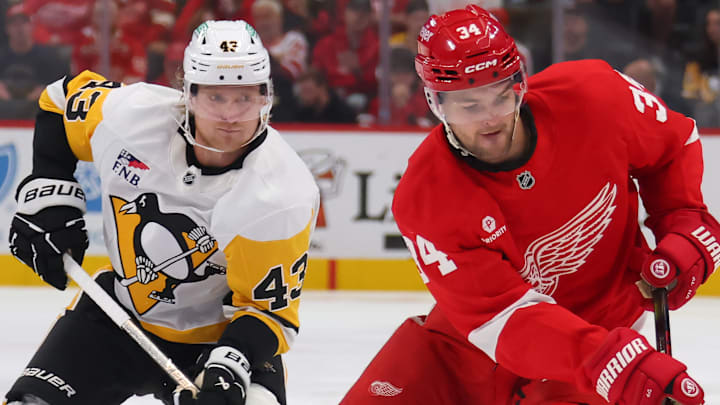The Detroit Red Wings are nearing the end of their exhibition slate. Their conclusion, of course, signals the imminence of the 2025–26 regular season—a moment charged with both anticipation and uncertainty.
As is the case with every Opening Night across professional sports, roster composition remains the most tantalizing unresolved question. Who will claim those final spots? Which prospects will force the hand of management, and which veterans may find themselves displaced? Surprises are always possible, though patterns from training camp and preseason offer a preliminary sketch.
With that in mind, here is my projection for how the Red Wings’ roster will crystallize as the curtain rises on a new campaign.
Line 1
For the Red Wings’ top line, continuity reigns. There will be no alterations from last season: Dylan Larkin, the franchise’s captain since January 2021, remains the anchor at center, flanked by Lucas Raymond on the right and Alex DeBrincat on the left. The chemistry among this trio is already well established, and the prospect of watching them reprise their dynamic interplay should prove one of the team’s early-season joys.
What distinguishes this year from the last, however, is the infrastructure surrounding them. The organization has invested in fortifying the defensive corps and shoring up the goaltending situation—adjustments that should afford the first line greater latitude to exploit their offensive strengths. In theory, that added stability behind them provides the cushion necessary for these forwards not merely to produce but to flourish as the true engine of Detroit’s attack.
Line 2
In the wake of a strong preseason showing, some have suggested that rookie Emmitt Finnie might assume the left-wing role on Detroit’s top line. While such a move carries a certain allure, it would be premature to place him in that position at this juncture. DeBrincat, after all, is coming off one of his most productive stretches in recent memory. Following a career-high 41-goal campaign with the Chicago Blackhawks in 2021–22, DeBrincat posted consecutive 27-goal seasons before rebounding to 39 goals last year.
The chemistry among Larkin, Raymond, and DeBrincat has matured over the past season, evolving into a nuanced interplay that underpins much of Detroit’s offensive identity. To abruptly displace an established contributor in favor of an untested rookie risks disrupting that equilibrium. Beyond the tactical implications, there is the relational dimension: alienating one of your premier players without necessity could generate friction that undermines both performance and morale.
Turning to the second line, Marco Kasper occupies the 2C spot, flanked by Patrick Kane on the right and Finnie on the left. This configuration presents a compelling blend of youth and experience. Finnie, in particular, evokes comparisons to a young Kane—possessing a similar creative instinct and dynamic approach to the game. Observing how these attributes interact on the ice promises to be one of the more intriguing storylines as Detroit navigates the early stages of the season.
Line 3
The third line introduces one of Detroit’s newest acquisitions, Mason Appleton, who arrives in Hockeytown from another storied hockey city, Winnipeg. Appleton will assume the right-wing position, with Andrew Copp anchoring the center and Michael Rasmussen occupying the left.
Beyond his role in five-on-five play, Appleton is poised to be a central figure on the Red Wings’ penalty kill—an area that has historically presented challenges for the franchise. His presence, experience, and defensive acumen could provide much-needed stability and effectiveness in shorthanded situations.
Line 4
On the fourth line, Detroit integrates new addition James van Riemsdyk, who, like Mason Appleton, is expected to bring reliability to the penalty kill. The 36-year-old New Jersey native has traversed multiple organizations in recent seasons, yet the majority of his NHL tenure was spent with the Philadelphia Flyers, where he developed a reputation for consistency and positional awareness.
Complementing van Riemsdyk are two capable depth forwards: center J.T. Compher, a 2022 Stanley Cup champion with the Colorado Avalanche, and Jonatan Berggren, a young player striving to solidify his place within the Red Wings’ roster. Together, this quartet provides a balance of experience, skill, and incentive-driven performance that could prove critical in both even-strength and shorthanded situations.
Defense
On the first pairing, we see the combination of Ben Chiarot and Moritz Seider. Chiarot brings a veteran presence and physicality, while Seider, the cornerstone of Detroit’s defensive future, continues to blend poise, mobility, and offensive vision into a dynamic two-way game. This duo should serve as the anchor of both the penalty kill and high-leverage situations.
The second pairing features Simon Edvinsson alongside Albert Johansson. Edvinsson, with his impressive reach and skating ability, complements Johansson’s steady, methodical approach, creating a pairing capable of transitioning smoothly from defense to attack while maintaining positional integrity.
The third pairing is where things become more nuanced. I would slot Erik Gustafsson with Axel Sandin-Pellikka, a combination of experience and youthful potential. Sandin-Pellikka, whose vision and decision-making are already NHL-caliber, benefits from Gustafsson’s steadiness and positional awareness. Notably, Justin Holl is not in the lineup at all in our projection.
Rounding out the defensive corps are Jacob-Bernard Docker and Travis Hamonic. This pairing is expected to inject physicality and grit, providing the Red Wings with a reliable shutdown option against opposing top lines and a stabilizing presence in the defensive zone.
Overall, this configuration blends youth, experience, and a spectrum of skill sets, reflecting a balance of immediate competitiveness and long-term developmental strategy. As always, adjustments are likely once the season commences, and the team’s coaching staff will undoubtedly adapt based on matchups and performance trends. We are keen to hear your perspectives on this projection and how you envision Detroit’s defensive alignments evolving over the course of the new season.
Bon voyage!
